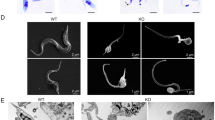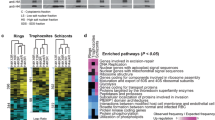Abstract
Histones of trypanosomes are quite divergent when compared to histones of most eukaryotes. Nevertheless, the histone H4 of Trypanosoma cruzi, the protozoan that causes Chagas’ disease, is acetylated in the N terminus at lysines 4, 10, and 14. Here, we investigated the cellular distribution of histone H4 containing each one of these posttranslational modifications by using specific antibodies. Histone H4 acetylated at lysine 4 (H4-K4ac) is found in the entire nuclear space preferentially at dense chromatin regions, excluding the nucleolus of replicating epimastigote forms of the parasite. In contrast, histone H4 acetylated either at K10 or K14 is found at dispersed foci all over the nuclei and at the interface between dense and nondense chromatin areas as observed by ultrastructural immunocytochemistry. The level of acetylation at K4 decreases in nonreplicating forms of the parasites when compared to K10 and K14 acetylations. Antibodies recognizing the K14 acetylation strongly labeled cells at G2 and M stages of the cell cycle. Besides that, hydroxyurea synchronized parasites show an increased acetylation at K4, K10, and K14 after S phase. Moreover, we do not observed specific colocalization of K4 modifications with the major sites of RNA polymerase II. Upon γ-irradiation that stops parasite replication until the DNA is repaired, dense chromatin disappears and K4 acetylation decreases, while K10 and K14 acetylation increase. These results indicate that each lysine acetylation has a different role in T. cruzi. While K4 acetylation occurs preferentially in proliferating situations and accumulates in packed chromatin, K10 and K14 acetylations have a particular distribution probably at the boundaries between packed and unpacked chromatin.








Similar content being viewed by others
References
Abuin G, Freitas-Junior LHG et al (1999) Expression of trans-sialidase and 85 kDa glycoprotein genes in Trypanosoma cruzi is differentially regulated at the post-transcriptional level by labile protein factors. J Biol Chem 274(19):13041–13047
Allfrey YVG, Faulkner R et al (1964) Acetylation and methylation of histones and their possible role in the regulation of RNA synthesis. Proc Natl Acad Sci U S A 51(5):786–794
Alsford S, Horn D (2004) Trypanosomatid histones. Mol Microbiol 53(2):365–372
Alsford S, Kawahara T et al (2007) A sirtuin in the African trypanosome is involved in both DNA repair and telomeric gene silencing but is not required for antigenic variation. Mol Microbiol 63(3):724–736
Altaf M, Saksouk N et al (2007a) Histone modifications in response to DNA damage. Mutat Res 618(1–2):81–90
Altaf M, Utley RT et al (2007b) Interplay of chromatin modifiers on a short basic patch of histone H4 tail defines the boundary of telomeric heterochromatin. Mol Cell 28(6):1002–1014
Bannister AJ, Kouzarides T (2005) Reversing histone methylation. Nature 436(7054):1103–1106
Bilsland E, Downs JA (2005) Tails of histones in DNA double-strand break repair. Mutagenesis 20(3):153–163
Black JC, Choi JE et al (2006) A mechanism for coordinating chromatin modification and preinitiation complex assembly. Mol Cell 23(6):809–818
Camargo EP (1964) Growth and differentiation in Trypanosoma cruzi: origin of metacyclic trypomastigotes in liquid media. Rev Inst Med Trop São Paulo 6(3):93–100
Campbell DA, Thomas S et al (2003) Transcription in kinetoplastid protozoa: why be normal? Microb Infect 5(13):1231–1240
Clayton AL, Hazzalin CA et al (2006) Enhanced histone acetylation and transcription: a dynamic perspective. Mol Cell 23(3):289–296
Costelloe T, Fitzgerald J et al (2006) Chromatin modulation and the DNA damage response. Exp Cell Res 312(14):2677–2686
Cremer T, Kreth G et al (2000) Chromosome territories, interchromatin domain compartment, and nuclear matrix: an integrated view of the functional nuclear architecture. Crit Rev Eukaryot Gene Expr 10(2):179–212
da Cunha JPC, Nakayasu ES et al (2006) Post-translational modifications of Trypanosoma cruzi histone H4. Mol Biochem Parasitol 150(2):268–277
Das A, Bellofatto V (2004) Genetic regulation of protein synthesis in trypanosomes. Curr Mol Med 4(6):577–584
de Souza W (1984) Cell biology of Trypanosoma cruzi. Int Rev Cytol 86:197–283
Dossin FM, Schenkman S (2005) Actively transcribing RNA polymerase II concentrates on spliced leader genes in the nucleus of Trypanosoma cruzi. Eukaryot Cell 4(5):960–970
Elias MC, da Cunha JP et al (2007) Morphological events during the Trypanosoma cruzi cell cycle. Protist 158(2):147–157
Elias MC, Faria M et al (2002) Chromosome localization changes in the Trypanosoma cruzi nucleus. Eukaryot Cell 1(6):944–953
Elias MC, Marques-Porto R et al (2001) Transcription rate modulation through the Trypanosoma cruzi life cycle occurs in parallel with changes in nuclear organisation. Mol Biochem Parasitol 112(1):79–90
Elias MC, Vargas NS et al (2003) Organization of satellite DNA in the genome of Trypanosoma cruzi. Mol Biochem Parasitol 129(1):1–9
Fang J, Feng Q et al (2002) Purification and functional characterization of SET8, a nucleosomal histone H4-lysine 20-specific methyltransferase. Cur Biol 12(13):1086–1099
Garcia-Salcedo JA, Gijon P et al (2003) A chromosomal SIR2 homologue with both histone NAD-dependent ADP-ribosyltransferase and deacetylase activities is involved in DNA repair in Trypanosoma brucei. EMBO J 22(21):5851–5862
Groth A, Rocha W et al (2007) Chromatin Challenges during DNA Replication and Repair. Cell 128(4):721–733
Herceg Z, Wang ZQ (2005) Rendez-vous at mitosis: TRRAPed in the chromatin. Cell Cycle 4(3):383–387
Ingram AK, Horn D (2002) Histone deacetylases in Trypanosoma brucei: two are essential and another is required for normal cell cycle progression. Mol Microbiol 45(1):89–97
Janzen CJ, Fernandez JP et al (2006a) Unusual histone modifications in Trypanosoma brucei. FEBS Lett 580(9):2306–2310
Janzen CJ, Hake SB et al (2006b) Selective di- or trimethylation of histone H3 lysine 76 by two DOT1 homologs is important for cell cycle regulation in Trypanosoma brucei. Mol Cell 23(4):497–507
Kawahara T, Siegel TN et al (2008) Two essential MYST-family proteins display distinct roles in histone H4K10 acetylation and telomeric silencing in trypanosomes. Mol Microbiol 69(4):1054–1068
Kouzarides T (1999) Histone acetylases and deacetylases in cell proliferation. Curr Opin Genet Dev 9(1):40–48
Kowieski TM, Lee S et al (2007) Acetylation-dependent ADP-ribosylation by Trypanosoma brucei sir2. J Biol Chem 283(9):5317–5326
Machado CR, Augusto-Pinto L et al (2006) DNA metabolism and genetic diversity in Trypanosomes. Mutat Res 612(1):40–57
Mandava V, Fernandez JP et al (2007) Histone modifications in Trypanosoma brucei. Mol Biochem Parasitol 156(1):41–50
Marques Porto R, Amino R et al (2002) Histone H1 is phosphorylated in non-replicating and infective forms of Trypanosoma cruzi. Mol Biochem Parasitol 119(2):265–271
Mujtaba S, Zeng L et al (2007) Structure and acetyl-lysine recognition of the bromodomain. Oncogene 26(37):5521–5527
Murga M, Jaco I et al (2007) Global chromatin compaction limits the strength of the DNA damage response. J Cell Biol 178(7):1101–1108
Nightingale KP, O’Neill LP et al (2006) Histone modifications: signalling receptors and potential elements of a heritable epigenetic code. Curr Opin Genet Dev 16(2):125–136
Nishioka K, Rice JC et al (2002) PR-Set7 is a nucleosome-specific methyltransferase that modifies lysine 20 of histone H4 and is associated with silent chromatin. Mol Cell 9(6):1201–1213
Peterson CL, Laniel MA (2004) Histones and histone modifications. Curr Biol 14(14):546–551
Regis-da-Silva CG, Freitas JM et al (2006) Characterization of the Trypanosoma cruzi Rad51 gene and its role in recombination events associated with the parasite resistance to ionizing radiation. Mol Biochem Parasitol 149(2):191–200
Respuela P, Ferella M et al (2008) Histone acetylation and methylation at sites initiating divergent polycistronic transcription in Trypanosoma cruzi. J Biol Chem 283(6):15884–15892
Rice JC, Nishioka K et al (2002) Mitotic-specific methylation of histone H4 Lys 20 follows increased PR-Set7 expression and its localization to mitotic chromosomes. Genes Dev 16(17):2225–2230
Richards EJ, Elgin SC (2002) Epigenetic codes for heterochromatin formation and silencing: rounding up the usual suspects. Cell 108(4):489–500
Sabaj V, Aslund L et al (2001) Histone genes expression during the cell cycle in Trypanosoma cruzi. J Cell Biochem 80(4):617–624
Schneider R, Grosschedl R (2007) Dynamics and interplay of nuclear architecture, genome organization, and gene expression. Genes Dev 21(23):3027–3043
Shogren-Knaak M, Ishii H et al (2006) Histone H4-K16 acetylation controls chromatin structure and protein interactions. Science 311(5762):844–847
Siegel TN, Kawahara T et al (2008) Acetylation of histone H4K4 is cell cycle regulated and mediated by HAT3 in Trypanosoma brucei. Mol Microbiol 67(4):762–771
Sobel RE, Cook RG et al (1995) Conservation of deposition-related acetylation sites in newly synthesized histones H3 and H4. Proc Natl Acad Sci U S A 92(4):1237–1241
Tamburini BA, Tyler JK (2005) Localized histone acetylation and deacetylation triggered by the homologous recombination pathway of double-strand DNA repair. Mol Cell Biol 25(12):4903–4913
Toro GC, Galanti N (1990) Trypanosoma cruzi histones. Further characterization and comparison with higher eukaryotes. Biochem Int 21(3):481–490
Trojer P, Reinberg D (2007) Facultative heterochromatin: is there a distinctive molecular signature? Mol Cell 28(1):1–13
Vidanes GM, Bonilla CY et al (2005) Complicated tails: histone modifications and the DNA damage response. Cell 121(7):973–976
Villanova GV, Nardelli SC et al (2009) Trypanosoma cruzi bromodomain factor 2 (BDF2) binds to acetylated histones and is accumulated after UV irradiation. Int J Parasitol 39(6):665–673
Wurtele H, Verreault A (2006) Histone post-translational modifications and the response to DNA double-strand breaks. Curr Opin Cell Biol 18(2):137–144
Ziv Y, Bielopolski D et al (2006) Chromatin relaxation in response to DNA double-strand breaks is modulated by a novel ATM- and KAP-1 dependent pathway. Nat Cell Biol 8(8):870–876
Acknowledgments
We thank Dr. James Bangs (The University of Wisconsin) for the use of the three-dimensional deconvolution microscope and Claudio Rogerio de Oliveira for the technical help. This work was supported by grants from FAPESP, FAPERJ, and CNPq (Brazil). SCN and JPCC are FAPESP (Brazil) fellows.
Author information
Authors and Affiliations
Corresponding author
Additional information
Communicated by E.A. Nigg
Sheila Cristina Nardelli and Julia Pinheiro Chagas da Cunha contributed equally to this work.
Rights and permissions
About this article
Cite this article
Nardelli, S.C., da Cunha, J.P.C., Motta, M.C.M. et al. Distinct acetylation of Trypanosoma cruzi histone H4 during cell cycle, parasite differentiation, and after DNA damage. Chromosoma 118, 487–499 (2009). https://doi.org/10.1007/s00412-009-0213-9
Received:
Revised:
Accepted:
Published:
Issue Date:
DOI: https://doi.org/10.1007/s00412-009-0213-9




